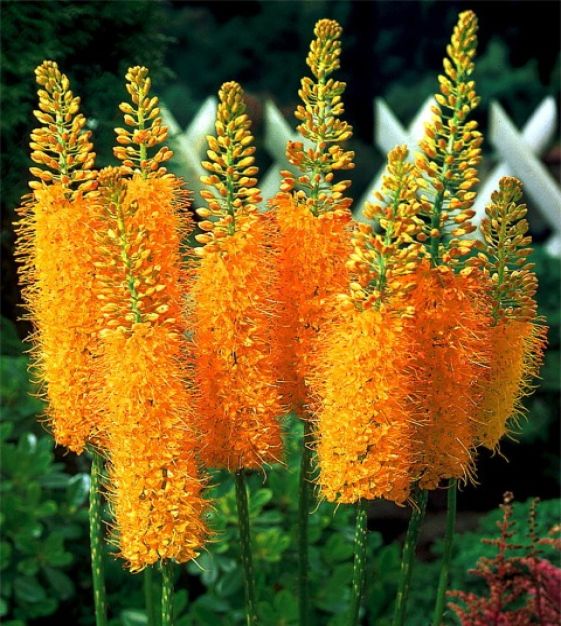-
- 20%-Off Website Specials
- New for 2024!
- Tulips
- Narcissi
- Allium
- Anemone blanda
- Brodiaea
- Camassia
- Chionodoxa
- Corydalis
- Crocus
- Eranthis
- Eremurus
- Erythronium
- Fritillaria
- Galanthus
- Geranium
- Gladiolus
- Hyacinths
- Hyacinthoides
- Ipheion uniflorum
- Dutch Iris
- Rock Garden Iris
- Ixiolirion
- Leucojum Aestivum
- Muscari
- Ornithogalum
- Oxalis
- Puschkinia
- Scilla
- Lilies
- Peonies
- Tender Bulbs
- Anemone Giants
- Tecolote Ranunculus
- Freesias
- Paperwhites
- Amaryllis
Eremurus ruiter-Hybrid Pinocchio
It is dark to pale russet-yellow with yellow stamens. Top size tuberous rootstocks. May/June. HZ: 5-8. Height: 3' to 6'.
Eremurus are The Art & Soul of Spring.
Eremurus Horticultural Tips
Eremurus are The Art & Soul of Spring.
Eremurus Horticultural Tips
- Information
Eremurus
Commonly known as Desert Candles or Foxtail Lilies, these tall willowy spires are comprised of densely-packed flowers that open progressively from the bottom of each spike up, with a sparse, ground-level rosette of long strappy leaves. Deer-and rodent-resistant, Eremurus prefers rich, well-draining soil in a dry spot with bright sunlight and protection from wind. Not a bulb, but a spider-like, woody tuberous rootstock, Eremurus do not like being out of the soil, so plant immediately upon receipt. The rootstocks dry out after harvest and rehydrate once planted.
Loosen the soil at each individual planting site: 36” apart (never overcrowd them). Imagine the rootstock as your hand with the fingers outstretched. The top of the back of your hand is the “nose” or the pointed crown of the Eremurus, and your fingers are its spidery tentacles. Gently place each brittle, spidery rootstock with its pointed crown facing up and the fingers spread out. Do your best to avoid rootstock breakage. Cover the top of the rootstock with a scant 2" to 3" of soil. In marginal microclimates or in areas with cold winters and inconsistent snow cover, a 2" layer of mulch should be applied after the top of the ground freezes to protect the shallow rootstocks from temperature spikes and early spring frosts. Top size, tuberous rootstocks. Bloom time: May/June. HZ: 5-8. Height: 3' to 6'.
Eremurus
Commonly known as Desert Candles or Foxtail Lilies, these tall willowy spires are comprised of densely-packed flowers that open progressively from the bottom of each spike up, with a sparse, ground-level rosette of long strappy leaves. Deer-and rodent-resistant, Eremurus prefers rich, well-draining soil in a dry spot with bright sunlight and protection from wind. Not a bulb, but a spider-like, woody tuberous rootstock, Eremurus do not like being out of the soil, so plant immediately upon receipt. The rootstocks dry out after harvest and rehydrate once planted.
Loosen the soil at each individual planting site: 36” apart (never overcrowd them). Imagine the rootstock as your hand with the fingers outstretched. The top of the back of your hand is the “nose” or the pointed crown of the Eremurus, and your fingers are its spidery tentacles. Gently place each brittle, spidery rootstock with its pointed crown facing up and the fingers spread out. Do your best to avoid rootstock breakage. Cover the top of the rootstock with a scant 2" to 3" of soil. In marginal microclimates or in areas with cold winters and inconsistent snow cover, a 2" layer of mulch should be applied after the top of the ground freezes to protect the shallow rootstocks from temperature spikes and early spring frosts. Top size, tuberous rootstocks. Bloom time: May/June. HZ: 5-8. Height: 3' to 6'.





